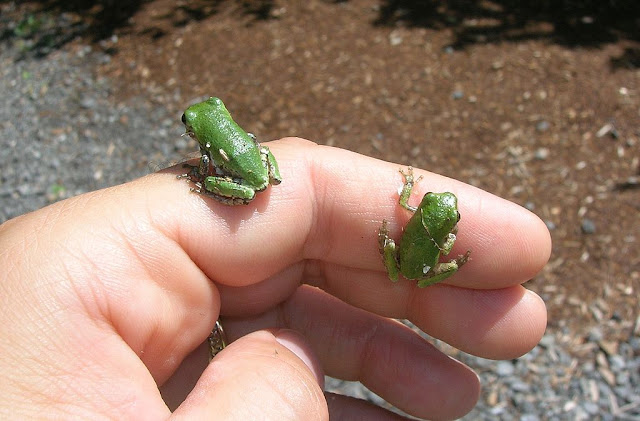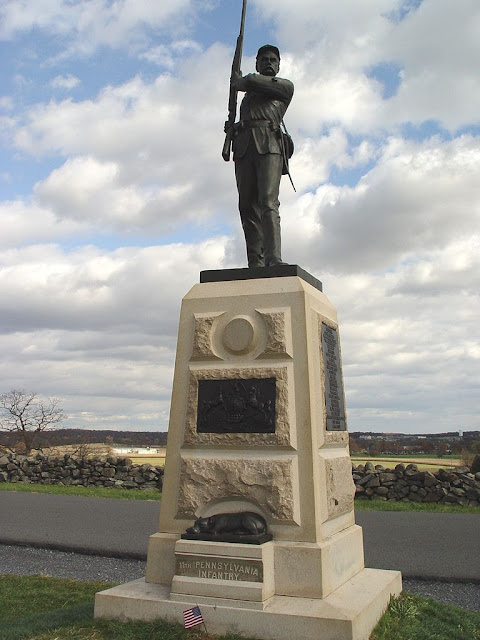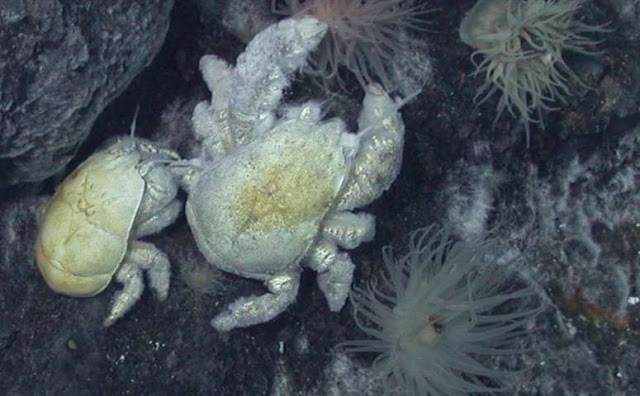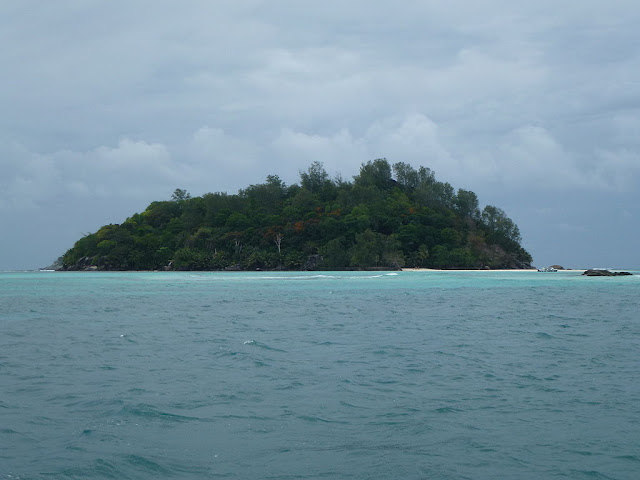Summary: Hyla versicolor is a New World arboreal frog native to southeastern Canada and central and eastern United States. Eastern Gray Treefrogs quickly camouflage.
| Two male Eastern Gray Tree Frogs display camouflage abilities: Dustykid, Public Domain via Wikimedia Commons |
Hyla versicolor is a New World frog native to eastern North America.
The small, tailless amphibian claims homelands in southeastern Canada from Manitoba through Ontario and Quebec. A disjunct, or separate, population is found in New Brunswick.
In the eastern United States, Hyla versicolor has a wide geographic range sweeping from the Great Plains eastward to the Atlantic coast.
Hyla versicolor is known commonly in English as common gray treefrog, Eastern gray treefrog, North American treefrog or tetraploid gray treefrog.
Eastern Gray Treefrogs enjoy arboreal (Latin: arbor, “tree”) habitats, such as forested areas, rural landscapes, and woodland ponds. During the breeding season they favor proximity to shallow water ecosystems, such as roadside ditches, swamps and vernal (Latin: ver, “spring”) pools.
Eastern Gray Treefrogs measure around 0.5 to 0.7 inches (13 to 20 millimeters) as newly transformed froglets. As adults, they maximize at lengths of around 1.25 to 2.5 inches (32 to 62 millimeters).
The dorsal, or back, of Eastern Gray Treefrogs presents a warty appearance. Eastern Gray Treefrogs reveal a dark patterning on their backs and express a mottled coloration range of gray or white to brown or green as a camouflaging response to their environment.
Bright orange-to-yellow coloring splashes across the ventral surface, or underside, of Eastern Gray Treefrogs’ hind legs. The bright flashes, which are exposed strategically during leaps, tend to startle predators.
Eastern Gray Treefrogs display slight sexual dimorphism (Ancient Greek: δίς, dís, “twice” + μορφή, morphḗ, “form, shape” + -ισμός, -ismós, suffix forming abstract nouns). Males are smaller than females. Males have vocal sacs for calling during mating season and darkened throats while females have light throats and do not vocalize.
Eastern Gray Treefrogs are virtually indistinguishable physically from Cope’s Gray Treefrog (Hyla chrysoscelis), also known as Southern Gray Treefrogs. Enjoying a great native range, Cope’s Gray Treefrogs spill over from homelands shared with their lookalikes southward deep into peninsular Florida and westward deep into the Great Plains.
Males of the two lookalike species may be identified audially by notes per second in their mating calls. Eastern Gray Treefrogs trill about 17 to 35 notes per second whereas Cope’s Gray Treefrogs speed at higher pitched trills of 35 to 70 notes per second.
The lookalikes may also be distinguished microscopically by chromosome tally. Hyla versicolor’s common name of Tetraploid (Ancient Greek: τέσσαρες, téssares, “four” + εἶδος, eîdos, “form, likeness”) Gray Treefrog reflects its possession of four sets of chromosomes, for a total of 48. As diploids (Ancient Greek: διπλοῦς, diploûs, “double”+ εἶδος, eîdos, “form, likeness”), Cope’s Gray Treefrogs retain two sets, for a total of 24.
Over the Memorial Day weekend, as I approached my house’s downstairs back door from the yard’s eastern, ephemeral creek border, I noticed a curved outline protruding above the southern edge of the top of the doorframe. My guest was an Eastern Gray Treefrog, hunkered down in a great, predatory location only inches away from the outside light, a favorite gathering spot for insects.
A nudging with the golden brown wooden handle of my garden rake induced the frog to jump onto the sturdy tool. As I lowered the rake, the frog jumped onto the concrete stoop and immediately discolored from light green to dull gray.
As my visitor’s home probably was sited either in the willow (Salix spp.) grove on the creek’s south banks or along the vernal pool slightly east of the grove, I nudged him into a tin pail and transported him to the south bank. Pausing slightly, my froggy guest traced a graceful arc in his leap across the creek and into the underbrush.
 |
| gray tree frogs, Macoun Marsh, Ottawa, South East Ontario, east central Canada: Leveilleee, CC BY SA 3.0, via Wikimedia Commons |
Acknowledgment
My special thanks to talented artists and photographers/concerned organizations who make their fine images available on the internet.
Image credits:
Image credits:
Two male Eastern Gray Tree Frogs display camouflage abilities: Dustykid, Public Domain via Wikimedia Commons @ https://commons.wikimedia.org/wiki/File:2GreyTreeFrogs.JPG
gray tree frogs, Macoun Marsh, Ottawa, Ontario, Canada: Leveilleee, CC BY SA 3.0, via Wikimedia Commons @ https://commons.wikimedia.org/wiki/File:Gray_treefrogs_at_Macoun_Marsh.jpg
For further information:
For further information:
Capranica, Robert R., and Anne J.M. Moffat. “Neurobehavioral Correlates of Sound Communication in Anurans.” Pages 701 – 730. In: Jorg-Peter Ewert, ed., Advances in Vertebrate Neuroethology. NATO ASI (Advanced Study Institute) Series A: Life Sciences, Vol. 56. New York: Plenum Press, 1983.
Elliott, Lang, Carl Gerhardt, and Carlos Davidson. The Frogs and Toads of North America: A Comprehensive Guide to Their Identification, Behavior, and Calls. Boston MA and New York NY: Houghton Mifflin Harcourt, 2009.
“Gray Treefrog Hyla versicolor.” Virginia Herpetological Society > Amphibians > Frogs and Toads.
Available @ http://www.virginiaherpetologicalsociety.com/amphibians/frogsandtoads/gray-treefrog/gray_treefrog.php
Available @ http://www.virginiaherpetologicalsociety.com/amphibians/frogsandtoads/gray-treefrog/gray_treefrog.php
Marriner, Derdriu. "Gray Tree Frogs: Garden Gate Icons and Keystone North American Species." Earth and Space News. Sunday, Feb. 1, 2015.
Available @ https://earth-and-space-news.blogspot.com/2015/02/gray-tree-frogs-garden-gate-icons-and.html
Available @ https://earth-and-space-news.blogspot.com/2015/02/gray-tree-frogs-garden-gate-icons-and.html
Mueller, Lee A. “Hyla versicolor Gray Treefrog.” Animal Diversity Web. Last updated April 22, 2006.
Available @ http://animaldiversity.org/accounts/Hyla_versicolor/
Available @ http://animaldiversity.org/accounts/Hyla_versicolor/
"The 2012 USDA Plant Hardiness Zone Map." The National Gardening Association > Gardening Tools > Learning Library USDA Hardiness Zone > USDA Plant Hardiness Zone Map.
Available @ https://garden.org/nga/zipzone/2012/
Available @ https://garden.org/nga/zipzone/2012/












